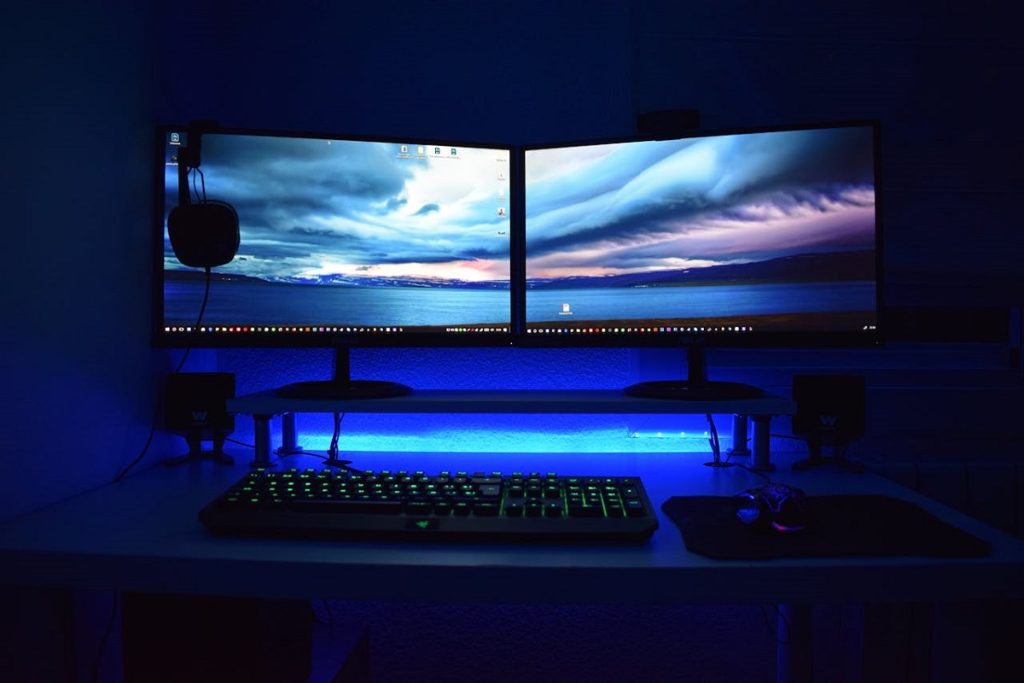RGB lighting has become a must-have for gamers and tech enthusiasts looking to create a vibrant, personalized gaming space. With customizable colors and effects, RGB lighting can transform any gaming setup into a visually stunning and exciting environment. But adding RGB isn’t just about adding a pop of color—done right, it can elevate the entire gaming experience. Here’s a guide on how to integrate RGB lighting for style, atmosphere, and functionality.
1. Start with RGB Backlighting for Your Monitor
One of the simplest yet most impactful places to add RGB lighting is behind your monitor. This backlighting, known as “bias lighting,” not only looks cool but can also reduce eye strain, especially during long gaming sessions in dim lighting.
- How to Set It Up: RGB light strips are commonly used for this effect and can be easily attached to the back of your monitor. Many strips offer color-syncing options, allowing the lights to match on-screen visuals, which is particularly amazing for gaming.
- Tip: Choose a color that complements your game or desktop environment, or opt for a color-cycling effect to add dynamic visuals. Some strips even respond to in-game audio, creating an ambient glow that changes with the action.
2. Upgrade Your Peripherals with RGB-Enhanced Devices
RGB peripherals like keyboards, mice, and headsets allow you to bring color directly to the items you interact with most. These devices can be customized to reflect your style or sync together for a coordinated look.
- Keyboards: Mechanical RGB keyboards are popular for their responsive keys and fully customizable lighting. You can set different colors for each key or choose effects like wave or reactive lighting that respond to keystrokes.
- Mice: RGB-enabled mice can offer more than just color. Some gaming mice allow you to customize lighting zones that respond to in-game events.
- Headsets: Many headsets have built-in RGB lighting that can sync with other devices, adding a sleek look when on display or when hanging on a headset stand.
Tip: Use the software that comes with each peripheral to sync lighting across your setup. Most major brands offer proprietary software, like Logitech G HUB or Razer Synapse, to streamline this process.
3. Brighten Your Desk with RGB Light Strips
RGB light strips are a flexible and affordable way to add color and creativity to your desk setup. You can place them along the back edge of your desk, under the desk, or even around the edge of your monitor stand.
- How to Set It Up: LED strips usually come with adhesive backing, making them easy to place in strategic spots. Some strips are USB-powered, while others need an outlet, so make sure to plan your power source.
- Tip: Choose addressable RGB (ARGB) strips if you want advanced lighting effects and individual LED customization. With ARGB, you can create gradients, animations, and synced lighting patterns.
4. Light Up Your PC Case with RGB Fans and Components
RGB components inside your PC case add a professional, futuristic look, allowing you to showcase your build through the case window. RGB fans, RAM, and even graphics cards can contribute to a vibrant, cohesive look.
- RGB Fans: Fans with customizable lighting not only cool your PC but also add an aesthetic touch. Many fans allow you to adjust color and brightness, adding depth to your case lighting.
- Other RGB Components: RAM sticks, motherboards, and graphics cards often come with RGB lighting options that can sync with other components. They add a colorful glow to the internals of your build.
Tip: Look for RGB components that are compatible with the same software, such as ASUS Aura Sync, MSI Mystic Light, or Gigabyte RGB Fusion, to sync everything within the case.
5. Use RGB Lighting Panels for a Futuristic Look
For those looking to go beyond traditional RGB strips and peripherals, RGB lighting panels can be a game-changer. These modular panels allow you to create unique, customizable wall designs that add an artistic and dynamic backdrop to your gaming space.
- How to Set It Up: Brands like Nanoleaf and Govee offer modular panels that you can connect in various shapes and configurations. You can adjust brightness, color, and effects, and even sync the lights with your music or in-game audio.
- Tip: Experiment with layouts and colors to match your gaming aesthetic. RGB panels are great for adding depth and energy to your gaming space, making it feel like a futuristic control room.
6. Enhance Ambiance with RGB Light Bars and Floor Lamps
RGB light bars and floor lamps can enhance your room’s overall ambiance, casting a soft glow that complements your gaming setup without overpowering it.
- RGB Light Bars: Compact and versatile, RGB light bars can be placed behind your monitor, on shelves, or even on the floor. They’re great for creating ambient lighting that fills the room without harsh glare.
- RGB Floor Lamps: For a more dramatic effect, RGB floor lamps can brighten larger spaces and add a bold splash of color. Many models come with app controls, allowing you to adjust colors, brightness, and effects with ease.
Tip: Position the lights to reflect off walls or the ceiling, creating a softer, more exciting glow that envelops the whole space.
7. Sync Everything Together for a Cohesive Look
With multiple RGB devices, having them synchronized can elevate the aesthetic of your entire setup. A synchronized setup not only looks organized but also makes the lighting effects more impactful.
- How to Sync: Use the lighting software that accompanies your RGB components and peripherals, like Corsair iCUE, Razer Chroma, or Logitech G HUB. These programs allow you to coordinate effects and colors across devices.
- Tip: Create profiles for different games or moods. For example, use a cool blue scheme for chill games and a fiery red for action games.

